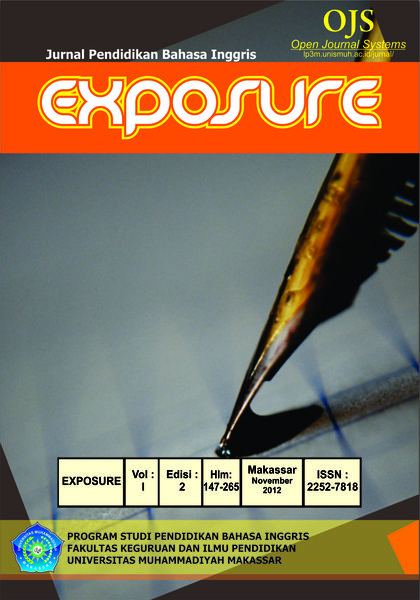IMPROVING THE STUDENTS’ SPEAKING ACCURACY THROUGH “LSE 9.0 SOFTWARE VERSION”
DOI:
https://doi.org/10.26618/exposure.v1i2.777Abstract
The objective of the research was to find out the improvement students’ speaking accuracy through Learn to Speak English 9.0 Software Version at SMK Negeri 1 Pattallassang Gowa. This research used classroom action research that consists two cycles. The research object was the first year electric students’ of SMK Negeri 1 Pattallassang Gowa academic year 2011/2012. The object of this research consisted of 32 students. The researcher obtained the data by using the speaking test in the diagnostic test, the cycle I and Cycle II. The results of the student's speaking test in cycle I and cycle II had significantly different scores. There was a better improvement of gains by students at the end of action cycle II. The research findings indicated that use of Learn to Speak English 9.0 Software as teaching media could improve the students’ speaking accuracy after evaluation in cycles I and II, the means scores in diagnostic test is 5.21 and then it became 5.95 in the cycle I and 7.10 in the cycle II. It can be stated that the students’ speaking accuracy at the first year electric students’ of SMK Negeri 1 Pattallassang Gowa was in poor level after the test in the diagnostic test with mean score 5.21 had improved to fairly good level after the test in the cycle II with mean score 7.10.
Keyword: Speaking, accuracy, LSE 9.0 software version
References
Brown, Douglas. 2007. Teaching by Principles: and Interactive Approach to Language Pedagogy, Third Edition. San Francisco. Pearson. Longman.
Crystal, David. 1993. A Dictionary of Linguistics and Phonetics. Cambridge USA
Delcloque P. 2000. History of CALL. Retrieved from: http://www.ict4lt.org/en/History_of_CALL.pdf. May 20th, 2010.
Dent, C. 2001. Studier: classification v. categorization. Retrieved from: http://www.burningchrome.com:8000/~cdent/fiaarts/docs/1005018884:23962.html. May 16th, 2010.
Gay, L. R. 1981. Educational Research Competency For Analysis and application. Florida. Bell and Howell Company.
Gong, Julia. 2002. The Employment of CALL in Teaching Second/Foreign Language Speaking Skills. Post-Script is published by the Faculty of
Education at the University of Melbourne, Australia. Retrieved from: www.edfac.unimelb.edu.au/insight/pscript.shtml. June 6th, 2010.
Gips, A., DiMattia, P., & Gips, J. 2004. The effect of assistive technology on educational costs: Two case studies. In K. Miesenberger.
Heaton, J. B 1989. Writing English Language Test. New York: Longman Group UK Limited.
Pedler, Mike. 2003. Learn to Speak English 9.0.Retrieved from http://amazon.com/learn_to_speak_english_software.htm. 20 May 2010.
Warschauer, Mark. 2008. Computer Assisted Language Learning. Retrieved from: http://en.wikipedia.org/wiki/Computer-assisted_language_learning.htm. 25 May 2010.
Kayi, Hayriye, Teaching Speaking: Activities to Promote Speaking in a Second Language. The Internet TESL Journal, Vol. XII, No. 11,
November 2006. Retrieved from: iteslj.org/Techniques/Kayi-TeachingSpeaking.html. June 7th, 2010.
Nunan, D. 1999. Second language teaching & learning. Boston: Heinle & Heinle Publishers.
Layman.1972. Technique in Testing. New York. Oxford University.
Levy, M. 1997. Computer-assisted language learning: context and conceptualization. Oxford, New York: Clarendon Press.
Lee, K.W. 2000. English teachers’ barriers to the use of computer-assisted language learning, The Internet TESL Journal. Retrieved from: http://www.4english.cn/englishstudy/xz/thesis/barrir.htm. May 20th, 2010.
Ormrod, J.E. (1999). Human Learning (3rd Edition). Upper Sadle River, NJ: Merrill Prentice Hall.
Roblyer, M. (2003). Integrating educational technology into teaching. Columbus, Ohio: Person Education.
Taylor, R. (1980). The computer in the school: Tutor, tool, and tutee. New York: Teachers College Press.
Ur, Penny. (1996). A Course in Language Teaching: Practice and Theory. Cambridge: Cambridge University Press.
Downloads
Published
Issue
Section
License
Authors who publish with this journal agree to the following terms:
In order to assure the highest standards for published articles, a peer review policy is applied. In pursue of the compliance with academic standards, all parties involved in the publishing process (the authors, the editors and the editorial board and the reviewers) agree to meet the responsibilities stated below in accordance to the Journal publication ethics and malpractice statement.
Duties of Authors:
- The author(s) warrant that the submitted article is an original work, which has not been previously published, and that they have obtained an agreement from any co-author(s) prior to the manuscript’s submission;
- The author(s) should not submit articles describing essentially the same research to more than one journal;
- The authors(s) make certain that the manuscript meets the terms of the Manuscript Submission Guideline regarding appropriate academic citation and that no copyright infringement occurs;
- The authors(s) should inform the editors about any conflict of interests and report any errors they subsequently, discover in their manuscript.
Duties of Editors and the Editorial Board:
- The editors, together with the editorial board, are responsible for deciding upon the publication or rejection of the submitted manuscripts based only on their originality, significance, and relevance to the domains of the journal;
- The editors evaluate the manuscripts compliance with academic criteria, the domains of the journal and the guidelines;
- The editors must at all times respect the confidentiality of any information pertaining to the submitted manuscripts;
- The editors assign the review of each manuscript to two reviewers chosen according to their domains of expertise. The editors must take into account any conflict of interest reported by the authors and the reviewers.
- The editors must ensure that the comments and recommendations of the reviewers are sent to the author(s) in due time and that the manuscripts are returned to the editors, who take the final decision to publish them or not.
Authors are permitted and encouraged to post online a pre-publication manuscript (but not the Publisher’s final formatted PDF version of the Work) in institutional repositories or on their Websites prior to and during the submission process, as it can lead to productive exchanges, as well as earlier and greater citation of published work (see The Effect of Open Access). Any such posting made before acceptance and publication of the Work shall be updated upon publication to include a reference to the Publisher-assigned DOI (Digital Object Identifier) and a link to the online abstract for the final published Work in the Journal.

